Fillings
We distinguish different types of tooth-colored fillings:
Direct restorations: (composite or more known as "white filling" and compomer or glass ionomer also more commonly used as temporary filling, underfill or in primary teeth)
Indirect restorations: custom porcelain filling.

Composite
In most cases, white fillings are placed. In addition to glass ionomer cement and compomer, composite is the most commonly used. A lot is possible with composite. For example, after a fracture, front teeth can be rebuilt and discolouration of teeth and molars can be restored.
It is beautifully white and can be used all over the mouth.
Composites consist of a plastic matrix filled with 25-80% ground glass, quartz or ceramic. The plastic is usually a polymethyl acrylate. Curing takes place here by polymerization of the monomers. Better known as 'the lamp' that is put on your tooth for a while. This contains UV light. A composite does not expand, but shrinks. This shrinkage can cause after-effects such as sensitivity to cold. One advantage is that it looks nice. Another very important advantage is that not as much tissue has to be drilled away as with amalgam. This is because it is chemically bonded and therefore does not depend on a shape. One drawback is that it is not as strong as amalgam. The mouth must be well 'laid dry' to be able to fill the hole properly.
Advantages: this filling looks nice, is relatively cheap and is ready in one sitting. Disadvantages: little wear-resistant, so a short lifespan. Due to the shrinkage when this filling hardens, there is a risk of leakage or after pain.

Risks
After the treatment (filling), the tooth may be somewhat sensitive. This should pass after a few weeks. Sometimes a filling is a little too high, the dentist can adjust this. If the symptoms do not subside or if they get worse, contact your dentist. If the filling is deep, a root canal treatment may (still) be required.
inlays
Instead of an amalgam filling or a white filling, the dentist may suggest the patient make a porcelain or ceramic inlay. An inlay or inlay filling is a custom-made filling of porcelain or (precious) metal.
After drilling and cleaning, we take an impression of the upper and lower teeth. The impression is then cast in plaster, after which porcelain inlays are made to measure in the laboratory. In the meantime you will receive a temporary inlay of synthetic resin. The inlay is glued into the tooth with an adhesive layer and a special type of composite cement. Advantages: wear-resistant and low risk of leakage and after-pain. Large gaps can also be filled with this. Optimal and original molar shape is restored and optimal edge closure and contact point is possible. This ensures durability of this type of filling, so less shrinkage, less chance of leakage, better cleanability and better bite shape, less chance of secondary caries. Cons: the high price and it has to be done in 2 sittings. However, if the damage to the tooth or molar is very extensive, the dentist can advise the application of a crown.


rubber dam
The rubber dam serves to keep the tooth dry
The rubber dam or rubber dam consists of a rubber patch in which one or more holes are made, in which the tooth(s) fit and which is stretched on a frame. The mouth is a moist environment. In addition, the saliva contains many bacteria. In order to be able to work clean and dry, the rubber dam (also called cofferdam) is used. The rubber dam consists of a rubber patch in which one or more holes are made, in which the tooth(s) fit and which is stretched on a frame. This way, the tooth that needs to be cared for is shielded from the rest of the mouth.
The advantage for the dentist is that his work area always remains clean and dry. It is also safer to work with rubber dams, which minimizes the risk of incidental ingestion of filling pieces, amalgam dust, or loose materials. The advantage for the patient is that holding it open can be done in a much more relaxed way. One can swallow regularly and no bits of material can fall into the mouth.
Source: KNMT , All about the teeth
Come visit us!
- info@mondzorg-valerius.nl
- +31 0 70 870 1466
- Valeriusstraat 25, 2517 HM The Hague